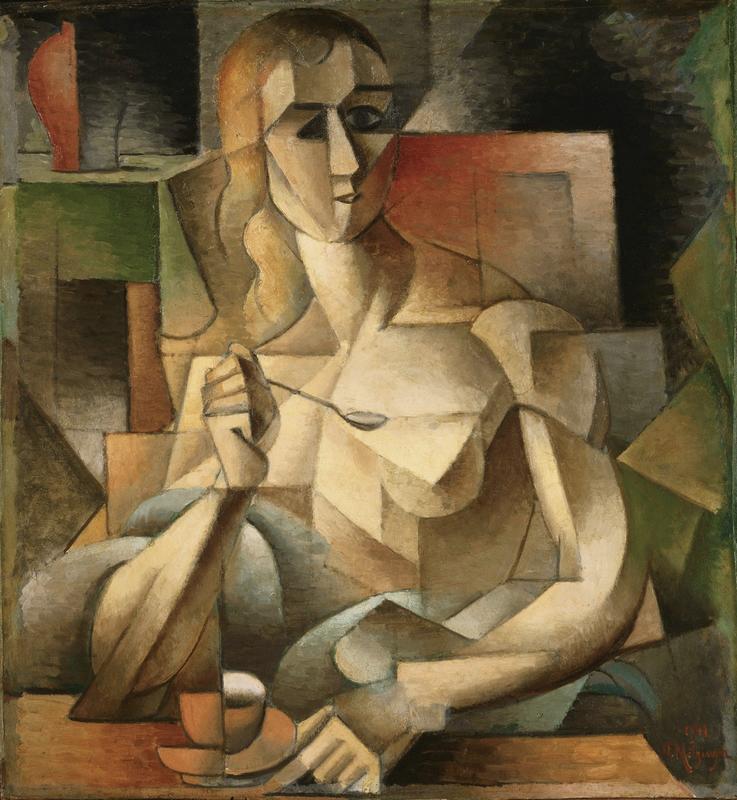More about Tea Time

Contributor
Jean Metzinger was once a poster child of Cubism, even more so than Picasso.
When Metzinger premiered Tea Time at a salon in 1911 with his friends Albert Gleizes and Henri Le Fauconnier, the painting was met with immediate success. This was in part thanks to literary figureheads like André Salmon, who helped organize the exhibition in the first place. He described the painting as the “Mona Lisa of Cubism.” Others joked it was the famous lady with a teaspoon.
Importantly, who we now see as masters of Cubism, like Picasso and Braque, were no shows at that first salon. It was Metzinger, instead, who was proclaimed as the chief of the new art form; Tea Time itself was much more popular than any other cubist artwork up to this point. Just goes to show that you can’t always expect what will stick to prevailing history, because Picasso, and not Metzinger, is now shorthand for anything geometric in art.
For a cubist painting, the smiling woman seated comfortably in Tea Time might seem overly pictorial. Her form is more schematized in triangles and rectangles than it is deformed by them. This was seen as an evolution of cubism for Metzinger and Gleizes, because it allowed for a more nuanced representation of person and place than the representational form. Yet, opposed to abstract inclinations, it remained firmly tethered to a physical reality.
In fact, Tea Time could be considered a proto-dimensionist work. If you look at the tea cup on the table, it is seen from two-different vantage points in the same, an instantaneous moment. Gleizes, writing about the painting, talks about how the shapes lend motion to the woman’s body, tying the work to both Futurism and the works of dimensionist artists like Isamu Noguchi.
If anything, in the speed of history, we somehow forgot how seminal Tea Time was for what is perhaps the quintessential 20th century art movement: cubism.
Sources
- Miller, Arthur I. Einstein, Picasso: Art and Science at the Invention of the 20th Century. New York: Basic Books, 2001.
- "Modern and Contemporary 439, Metzinger - Tea Time (Woman with a Teaspoon)." Philadelphia Museum of Art (audio blog). Accessed April 2019. http://www.philamuseum.org/collections/permanent/51056.html.
- Brooke, Peter. "On "Cubism" and Other Painters." Du Cubism and Other Related Texts. Accessed April 2019. http://www.peterbrooke.org.uk/a&r/Du Cubisme/Part two/picasso.
Featured Content
Here is what Wikipedia says about Tea Time (Metzinger)
Tea Time (French: Le Goûter, also known as Femme à la Cuillère or Woman with a teaspoon) is an oil painting created in 1911 by the French artist and theorist Jean Metzinger. It was exhibited in Paris at the Salon d'Automne of 1911, and the Salon de la Section d'Or, 1912.
The painting was first reproduced (illustrated) in Chroniques Médico-Artistique, Le Sabotage Anatomique au Salon d'Automne (1911). The following year it was reproduced in Du "Cubisme", by Jean Metzinger and Albert Gleizes (1912). In 1913 it was published in The Cubist Painters, Aesthetic Meditations (Les Peintres Cubistes) by Guillaume Apollinaire. The painting was subsequently published in Arthur Jerome Eddy's Cubists and Post-impressionism, 1914, titled The Taster.
Art critic Louis Vauxcelles in a literary newspaper Gil Blas, 30 September 1911, referred to Le goûter sarcastically as "la Joconde à la cuiller" (Mona Lisa with a spoon).
André Salmon dubbed this painting "La Joconde du Cubisme" ("La Joconde Cubiste"), "The Mona Lisa of Cubism" ("Mona Lisa with a teaspoon"). Tea Time "was far more famous than any painting that Picasso and Braque had made up until this time", according to curator Michael Taylor (Philadelphia Museum of Art), "because Picasso and Braque, by not showing at the Salons, have actually removed themselves from the public... For most people, the idea of Cubism was actually associated with an artist like Metzinger, far more than Picasso." (Taylor, 2010)
Le Goûter forms part of the Louise and Walter Arensberg Collection, Philadelphia Museum of Art.
Check out the full Wikipedia article about Tea Time (Metzinger)












